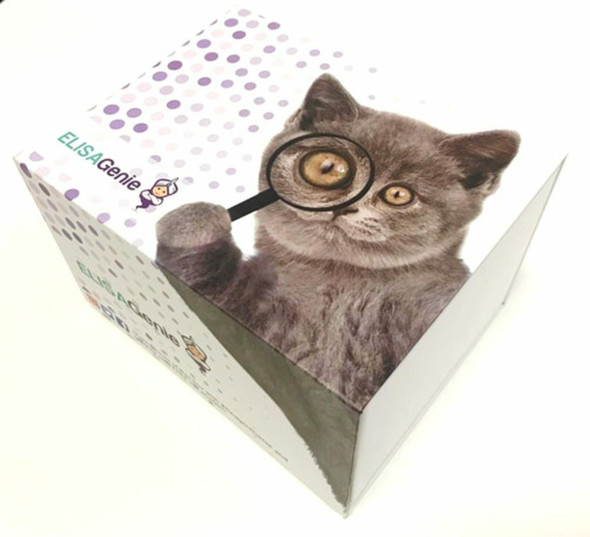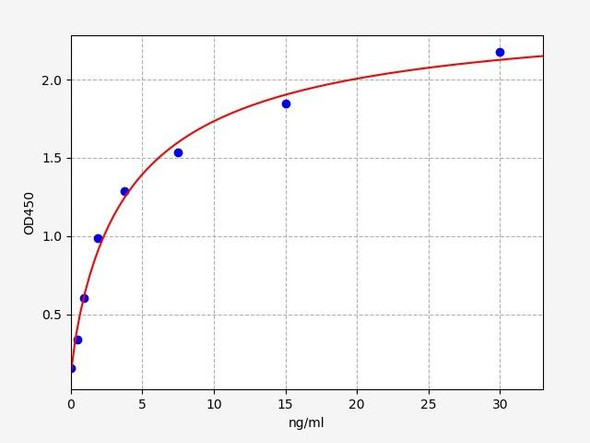Mouse OCT (Ornithine Carbamoyl Transferase) ELISA Kit (MOES01481)
- SKU:
- MOES01481
- Product Type:
- ELISA Kit
- Size:
- 96 Assays
- Uniprot:
- P11725
- Sensitivity:
- 0.94ng/mL
- Range:
- 1.56-100ng/mL
- ELISA Type:
- Sandwich
- Synonyms:
- OTC, OCTD, Ornithine Transcarbamylase
- Reactivity:
- Mouse
- Sample Type:
- Serum, plasma and other biological fluids
- Research Area:
- Metabolism
Description
Mouse OCT (Ornithine Carbamoyl Transferase) ELISA Kit
The Mouse OCT (Ornithine Carbamoyl Transferase) ELISA Kit is designed for the accurate detection of ornithine carbamoyl transferase levels in mouse serum, plasma, and cell culture supernatants. This kit features high sensitivity and specificity, ensuring reliable and reproducible results for your research needs. Ornithine carbamoyl transferase is a key enzyme involved in the urea cycle, playing a crucial role in the detoxification of ammonia in the body. Dysregulation of this enzyme has been implicated in various metabolic disorders and liver diseases, making it an important biomarker for studying these conditions and developing potential therapies.
With easy-to-follow protocols and quick assay times, the Mouse OCT ELISA Kit is a valuable tool for researchers looking to investigate the role of ornithine carbamoyl transferase in health and disease. Order your kit today and take your research to the next level.
| Assay type: | Sandwich |
| Format: | 96T |
| Assay time: | 4.5h |
| Reactivity: | Mouse |
| Detection Method: | Colormetric |
| Detection Range: | 1.56-100 ng/mL |
| Sensitivity: | 0.94 ng/mL |
| Sample Volume Required Per Well: | 100µL |
| Sample Type: | Serum, plasma and other biological fluids |
| Specificity: | This kit recognizes Mouse OCT in samples. No significant cross-reactivity or interference between Mouse OCT and analogues was observed. |
This ELISA kit uses Sandwich-ELISA as the method. The micro ELISA plate provided in this kit has been pre-coated with an antibody specific to Mouse OCT. Standards or samples are added to the appropriate micro ELISA plate wells and combined with the specific antibody. Then a biotinylated detection antibody specific for Mouse OCT and Avidin-Horseradish Peroxidase (HRP) conjugate are added to each micro plate well successively and incubated. Free components are washed away. The substrate solution is added to each well. Only those wells that contain Mouse OCT, biotinylated detection antibody and Avidin-HRP conjugate will appear blue in color. The enzyme-substrate reaction is terminated by adding Stop Solution and the color turns yellow. The optical density (OD) is measured spectrophotometrically at a wavelength of 450 nm ± 2 nm. The OD value is proportional to the concentration of Mouse OCT. The concentration of Mouse OCT in samples can be calculated by comparing the OD of the samples to the standard curve.
| UniProt Protein Function: | OTC: Defects in OTC are the cause of ornithine carbamoyltransferase deficiency (OTCD). OTCD is an X- linked disorder of the urea cycle which causes a form of hyperammonemia. Mutations with no residual enzyme activity are always expressed in hemizygote males by a very severe neonatal hyperammonemic coma that generally proves to be fatal. Heterozygous females are either asymptomatic or express orotic aciduria spontaneously or after protein intake. The disorder is treatable with supplemental dietary arginine and low protein diet. The arbitrary classification of patients into the 'neonatal' group (clinical hyperammonemia in the first few days of life) and 'late' onset (clinical presentation after the neonatal period) has been used to differentiate severe from mild forms. Belongs to the ATCase/OTCase family. |
| UniProt Protein Details: | Protein type:Mitochondrial; Transferase; Amino Acid Metabolism - arginine and proline; EC 2. 1. 3. 3 Cellular Component: mitochondrion; cytoplasm; mitochondrial inner membrane Molecular Function:transferase activity; amino acid binding; carboxyl- or carbamoyltransferase activity; ornithine carbamoyltransferase activity; phospholipid binding; phosphate binding Biological Process: amino acid metabolic process; citrulline biosynthetic process; arginine biosynthetic process; ornithine metabolic process; arginine biosynthetic process via ornithine; amino acid biosynthetic process; ornithine catabolic process; anion homeostasis; urea cycle |
| UniProt Code: | P11725 |
| NCBI GenInfo Identifier: | 6679184 |
| NCBI Gene ID: | 18416 |
| NCBI Accession: | NP_032795. 1 |
| UniProt Related Accession: | P11725 |
| Molecular Weight: | 39,765 Da |
| NCBI Full Name: | ornithine carbamoyltransferase, mitochondrial |
| NCBI Synonym Full Names: | ornithine transcarbamylase |
| NCBI Official Symbol: | Otc |
| NCBI Official Synonym Symbols: | Sf; spf; AI265390 |
| NCBI Protein Information: | ornithine carbamoyltransferase, mitochondrial; OTCase; sparse fur |
| UniProt Protein Name: | Ornithine carbamoyltransferase, mitochondrial |
| UniProt Synonym Protein Names: | Ornithine transcarbamylase; OTCase |
| Protein Family: | Ornithine carbamoyltransferase |
| UniProt Gene Name: | Otc |
| UniProt Entry Name: | OTC_MOUSE |
As the OD values of the standard curve may vary according to the conditions of the actual assay performance (e. g. operator, pipetting technique, washing technique or temperature effects), the operator should establish a standard curve for each test. Typical standard curve and data is provided below for reference only.
| Concentration (ng/mL) | O.D | Average | Corrected |
| 100 | 2.4 2.458 | 2.429 | 2.363 |
| 50 | 1.601 1.645 | 1.623 | 1.557 |
| 25 | 0.946 0.944 | 0.945 | 0.879 |
| 12.5 | 0.514 0.53 | 0.522 | 0.456 |
| 6.25 | 0.271 0.257 | 0.264 | 0.198 |
| 3.13 | 0.177 0.157 | 0.167 | 0.101 |
| 1.56 | 0.116 0.12 | 0.118 | 0.052 |
| 0 | 0.057 0.075 | 0.066 | -- |
Precision
Intra-assay Precision (Precision within an assay): 3 samples with low, mid range and high level Mouse OCT were tested 20 times on one plate, respectively.
Inter-assay Precision (Precision between assays): 3 samples with low, mid range and high level Mouse OCT were tested on 3 different plates, 20 replicates in each plate.
| Intra-assay Precision | Inter-assay Precision | |||||
| Sample | 1 | 2 | 3 | 1 | 2 | 3 |
| n | 20 | 20 | 20 | 20 | 20 | 20 |
| Mean (ng/mL) | 5.09 | 16.03 | 46.62 | 4.81 | 15.83 | 45.15 |
| Standard deviation | 0.27 | 0.91 | 1.67 | 0.27 | 0.73 | 1.35 |
| C V (%) | 5.30 | 5.68 | 3.58 | 5.61 | 4.61 | 2.99 |
Recovery
The recovery of Mouse OCT spiked at three different levels in samples throughout the range of the assay was evaluated in various matrices.
| Sample Type | Range (%) | Average Recovery (%) |
| Serum (n=5) | 93-107 | 99 |
| EDTA plasma (n=5) | 87-101 | 93 |
| Cell culture media (n=5) | 91-107 | 98 |
Linearity
Samples were spiked with high concentrations of Mouse OCT and diluted with Reference Standard & Sample Diluent to produce samples with values within the range of the assay.
| Serum (n=5) | EDTA plasma (n=5) | Cell culture media (n=5) | ||
| 1:2 | Range (%) | 98-108 | 89-102 | 86-99 |
| Average (%) | 103 | 96 | 91 | |
| 1:4 | Range (%) | 94-109 | 82-97 | 87-100 |
| Average (%) | 100 | 89 | 92 | |
| 1:8 | Range (%) | 94-107 | 82-93 | 86-98 |
| Average (%) | 99 | 87 | 92 | |
| 1:16 | Range (%) | 87-100 | 86-99 | 86-101 |
| Average (%) | 94 | 93 | 92 |
An unopened kit can be stored at 4°C for 1 month. If the kit is not used within 1 month, store the items separately according to the following conditions once the kit is received.
| Item | Specifications | Storage |
| Micro ELISA Plate(Dismountable) | 8 wells ×12 strips | -20°C, 6 months |
| Reference Standard | 2 vials | |
| Concentrated Biotinylated Detection Ab (100×) | 1 vial, 120 µL | |
| Concentrated HRP Conjugate (100×) | 1 vial, 120 µL | -20°C(shading light), 6 months |
| Reference Standard & Sample Diluent | 1 vial, 20 mL | 4°C, 6 months |
| Biotinylated Detection Ab Diluent | 1 vial, 14 mL | |
| HRP Conjugate Diluent | 1 vial, 14 mL | |
| Concentrated Wash Buffer (25×) | 1 vial, 30 mL | |
| Substrate Reagent | 1 vial, 10 mL | 4°C(shading light) |
| Stop Solution | 1 vial, 10 mL | 4°C |
| Plate Sealer | 5 pieces | |
| Product Description | 1 copy | |
| Certificate of Analysis | 1 copy |
- Set standard, test sample and control (zero) wells on the pre-coated plate and record theirpositions. It is recommended to measure each standard and sample in duplicate. Note: addall solutions to the bottom of the plate wells while avoiding contact with the well walls. Ensuresolutions do not foam when adding to the wells.
- Aliquot 100µl of standard solutions into the standard wells.
- Add 100µl of Sample / Standard dilution buffer into the control (zero) well.
- Add 100µl of properly diluted sample (serum, plasma, tissue homogenates and otherbiological fluids) into test sample wells.
- Cover the plate with the sealer provided in the kit and incubate for 90 min at 37°C.
- Aspirate the liquid from each well, do not wash. Immediately add 100µL of BiotinylatedDetection Ab working solution to each well. Cover the plate with a plate seal and gently mix. Incubate for 1 hour at 37°C.
- Aspirate or decant the solution from the plate and add 350µL of wash buffer to each welland incubate for 1-2 minutes at room temperature. Aspirate the solution from each well andclap the plate on absorbent filter paper to dry. Repeat this process 3 times. Note: a microplatewasher can be used in this step and other wash steps.
- Add 100µL of HRP Conjugate working solution to each well. Cover with a plate seal andincubate for 30 min at 37°C.
- Aspirate or decant the solution from each well. Repeat the wash process for five times asconducted in step 7.
- Add 90µL of Substrate Reagent to each well. Cover with a new plate seal and incubate forapproximately 15 min at 37°C. Protect the plate from light. Note: the reaction time can beshortened or extended according to the actual color change, but not by more than 30min.
- Add 50 µL of Stop Solution to each well. Note: Adding the stop solution should be done inthe same order as the substrate solution.
- Determine the optical density (OD value) of each well immediately with a microplate readerset at 450 nm.









